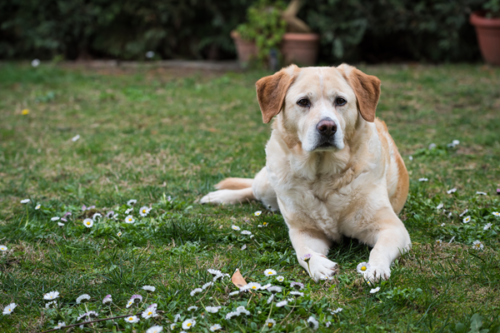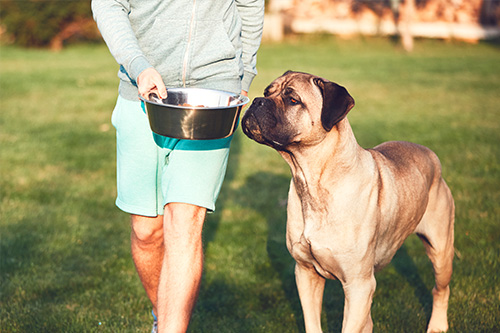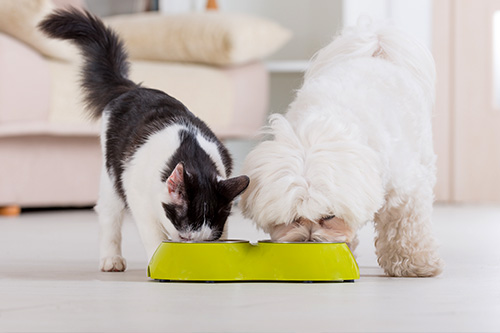
In North America, obesity is the most common preventable disease in dogs and cats. The Association for Pet Obesity Prevention reports that more than 50% of dogs are overweight and almost 60% of domestic cats are overweight.
What is obesity?
Using body weight as a guide, dogs are considered overweight when they weigh 10-20% above their ideal body weight. They are considered obese when they weigh more than 20% above their ideal body weight. Cats are considered overweight when they weigh 10-20% above their ideal body weight. Cats are considered obese when they weigh more than 20% above their ideal body weight.
What risks are posed by obesity?
Obesity shortens a dog & cat’s life and makes them more likely to develop disease. It was always accepted that overweight pets had a shorter lifespan than lean pets, usually by 6-12 months. However, a large, lifetime study of Labrador retrievers found that being even moderately overweight can reduce a dog’s life expectancy by nearly two years compared to their leaner counterparts. It is reasonable to expect we would see similar results in a study performed on overweight cats.
How can I tell if my cat is obese?
How can I tell if my cat is obese?
The first step in dealing with an overweight or obese cat is to recognize and acknowledge that there is a problem. Unfortunately, we are inundated with images in the media of overweight cats, making it challenging to understand what healthy looks like. Your veterinarian and veterinary health care team can assist with an assessment.

You can assess your cat’s body condition at home by checking how much fat they have covering their ribs and comparing that to the feel of your hand. Start by feeling the dog’s ribs just behind their front legs.
- If the ribs feel like the back of your hand, your cathas an excellent body condition.
- If the ribs feel like your knuckles, or stick out like knuckles, your dog is too thin.
- If the ribs feel like the palm of your hand, your dog is overweight.
This “hand test” is also a good measure of weight loss progress between formal weigh-ins.
Your veterinary health care team will provide an estimated ideal body weight to use as a target. Still, it is important that they also do regular body condition assessments to ensure your cat is moving toward having a normal body weight and body condition. Most veterinary practices use a body condition scoring system on a scale of either 1-5 (3 being ideal normal) or 1-9 (5 being ideal).
How do I adjust my cat’s meals to help him lose weight?
Once you have identified that your cat is overweight or obese, it is essential to adjust feedings for weight loss using an appropriate nutritional product, portion, and meal frequency. Veterinary-formulated diets help with healthy and safe weight reduction in cats, such as Hills® Prescription Diet Metabolic, Royal Canin® Satiety Support Weight Management, and Purina Overweight Management®. It is not appropriate to simply reduce the volume of their current food: this will cause malnourishment over time.
Feeding a special diet with a lower overall calorie density and an appropriate nutrient balance is essential. Your veterinarian can recommend and provide the best diet for your cat.
Once the new food has been selected and the new portions are determined, it is critical that you are consistent with feeding – portions and meal frequency – and resist the temptation to provide extra snacks. Ask your veterinarian how to include treats in your cat’s diet plan.
Monthly weigh-ins are a critical component of successful feline weight loss and keep everyone accountable. It is important to verify weight loss, to ensure that weight loss is neither too rapid nor too slow, and to determine when your cat has achieved a healthy body condition.
For more tips on reducing your cat’s weight, see the handouts “Creating a Weight Reduction Plan for Cats” and “Exercising Your Cat for Weight Loss”.
What happens when we reach our weight-loss goal?
Once ideal body weight and condition have been achieved, it is important to maintain your cat’s weight. It is important to gradually increase the amount you feed your cat while she maintains this healthy weight until she can safely transition to a maintenance diet (think of it as a “reverse diet” to help her metabolism adapt to a “normal” amount of food).
This process can take two to three months but is the best way to prevent a weight-gain rebound. Some cats, especially those who exhibit begging behaviors and are less active, may benefit from remaining on the weight-loss diet with slightly higher meal portions for maintenance. Your veterinary team can guide you through this process.
Portion control is critical at this stage to prevent regaining weight. After so much hard work, a relapse into obesity would be unfortunate. Yo-yo weight loss and gain are no healthier for cats than for humans. The benefits of normalizing body weight and condition make the effort well worth it.
How can I tell if my dog is obese?
The first step in dealing with an overweight or obese dog is to recognize and acknowledge that there is a problem. Unfortunately, we are inundated with images in the media of overweight dogs, making it challenging to understand what healthy looks like. Your veterinarian and veterinary health care team can assist with an assessment.

You can assess your dog’s body condition at home by checking how much fat they have covering their ribs and comparing that to the feel of your hand. Start by feeling the dog’s ribs just behind their front legs.
- If the ribs feel like the back of your hand, your dog has an excellent body condition.
- If the ribs feel like your knuckles, or stick out like knuckles, your dog is too thin.
- If the ribs feel like the palm of your hand, your dog is overweight.
This “hand test” is also a good measure of weight loss progress between formal weigh-ins.
Your veterinary health care team will provide an estimated ideal body weight to use as a target. Still, it is essential that they also do regular body condition assessments to ensure progress is being made toward normal body weight and body condition. Most veterinary practices use a body condition scoring system on a scale of either 1-5 (where 3 is ideal) or 1-9 (where 5 is ideal).
How do I adjust my dog’s meals to help him lose weight?
Once you have identified that your dog is overweight or obese, it is important to adjust feedings for weight loss, using a specific diet, a specific portion, and a specific meal frequency. There are veterinary formulated diets that help with healthy and safe weight reduction in dogs, such as Hills® Prescription Diet® Metabolic, Royal Canin® Satiety Support Weight Management, and Purina Overweight Management®. It is not appropriate to simply reduce the volume of their current food. This will cause malnourishment over time.
Feeding a diet with a lower overall calorie density that maintains an appropriate nutrient balance is essential. Your veterinary health care team can help you determine which nutritional products are best for your dog. Once the new food has been selected and the new portions are determined, it is critical that you are consistent with feeding – portions and meal frequency – and resist the temptation to provide extra snacks. Treats should compose no more than 10% of your dog’s daily calorie intake.
Monthly weigh-ins are important for successful canine weight loss and keep everyone accountable. It is essential to verify weight loss to ensure that it is neither too rapid nor too slow, and to determine when your dog has achieved a healthy body condition.
For more tips on reducing your dog’s weight, see the handouts “Creating a Weight Reduction Plan for Dogs” and “Walking Your Dog for Weight Loss”.
What happens when we reach our weight-loss goal?
Once ideal body weight and condition have been achieved, it is important to maintain that weight. Once again, your veterinary health care team can help you find appropriate food and portions for weight maintenance.
Portion control is critical at this stage to prevent regaining weight. After so much hard work, a relapse into obesity would be disappointing. Yo-yo weight loss and gain are no healthier for dogs than for humans. The benefits of normalizing body weight and condition make the effort well worth it.


